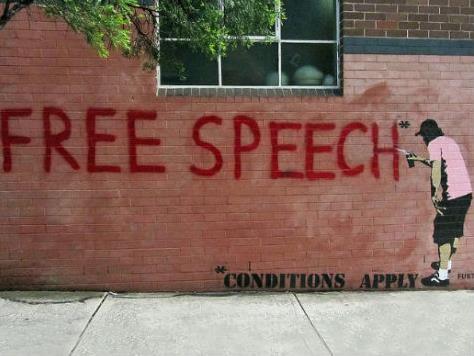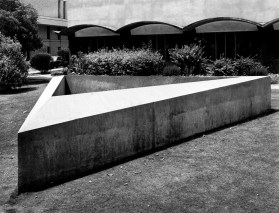Graffiti by fukt, Photo: Newtown Grafitti
Artists are outspoken in support of freedom of expression. The nature of their work is to push the boundaries of social discourse and say things those in authority would rather not hear.
But contemporary artists also know only too well that freedom of expression has its limitations and that we are certainly not living in a place or period where it is the highest value.
Just ask Paul Yore, who was charged with child pornography in Victoria over a work that included a collage of a young Justin Bieber directly above a urinating dildo. Yore was banned from Sydney Contemporary last year because management were afraid of obscenity charges over another work.
Or ask the owners of the Dogs’ Bar in Melbourne, which just a couple of weeks ago resorted to placing a fig leaf over a penis after being threatened with obscenity charges. Or photographer Bill Henson or…but you get the idea.
In a society where pornography is freely available online the energy and degree of offence taken over so-called obscene art is – and we use this word advisedly – perverse.
But it is also discordant when we consider that freedom of expression is a value being touted particularly loudly by the man who is both Federal Attorney-General and Minister for the Arts, Senator George Brandis.
Senator Brandis is spearheading the Government’s declared intention to repeal Section 18C of the Racial Discrimination Act, the section that limits freedom of speech which is ‘reasonably likely … to offend, insult, humiliate or intimidate’ individuals or groups on grounds of ‘race, colour or national or ethnic origin’.
Australia is in the odd position of retaining antiquated obscenity restrictions on freedom of speech while repealing more modern restrictions, placed because of the needs of a tolerant and diverse society.
The principles governing obscenity and racial vilification law are analogous. Restrictions of freedom of speech are justified when, and only when, the right to free speech conflicts with another equally important right.
Traditionally the law limits free speech in four areas. Defamation Law limits freedom of speech that harms the reputation of an individual; Contempt Law covering court orders and parliamentary proceedings limits freedom of speech when it conflicts with the workings of courts or parliament; Obscenity Law protect rights to privacy and decency; and Blasphemy Law protects the right of the God/the Church/ other religious authorities to respect.
Astute readers will pick immediately that there is something fishy about the last one because most Australians no longer take for granted that religious authorities have a God-given right to anything. Accordingly, there has not been a blasphemy case in Australia for almost a century and most Australian blasphemy laws were repealed in the early 1990s, including all Federal legislation. Changing public beliefs and norms mean we no longer consider taking God’s name in vain to be a matter for the police.
At much the same time as blasphemy ceased to be an offence, many jurisdictions, including the Australian Federal Government, introduced another restriction on freedom of speech. In 1995 the Keating Government amended the Racial Discrimination Act to include Section 18C, the racial vilification protection. This restriction follows exactly on the pattern of limiting freedom of speech in cases of conflicting rights that already exists, only in this case the right protected is the right to be free of offensive behaviour, humiliation and intimidation on racial or ethnic grounds.
Just as defamation law protects the right of the individual to be free from harm, Section 18C protects the right of the group. Just as obscenity laws – and formerly blasphemy laws – reference current community standards, racial vilification law depends on what we as a society consider acceptable discourse.
Sometimes known as the Racial Hatred Act, 18C recognises that expressed racial hatred is harmful, not just to the individual but also to other members of the group under attack and to the social cohesion of our society. Indeed it can be argued that racial vilification is more harmful than individual defamation for the same reasons that racist violence is more grievous that other forms of assault, because it has distant victims and incites community unrest.
We introduced racial vilification law for the same reasons we dispensed with blasphemy law, because freedom of speech must always be weighed against the other values we want in our society. As the 20th Century moved on it was clear that blasphemy harmed no one and racism harmed many.
Senator Brandis has made it clear that he believes the provisions of 18C are unnecessarily restrictive, his object lesson being the Andrew Bolt case which he referred to this week on Q&A, and which prompted Professor Marcia Langton to make inferences against Bolt which subsequently drew an apology from her and from the ABC.
But Bolt is not in danger. The communities most likely to be affected by the change are ethnic minorities and they overwhelmingly oppose change. The Indigenous, Greek, Jewish, Chinese, Arab, Armenian and Korean communities have put out a joint statement arguing that a repeal of 18C would be ‘licensing the public humiliation of people because of their race’.
The Abbott Government apparently believes that the right to freedom of speech overrides the rights of these minority communities to be free of humiliation and intimidation. But it does not believe that the right of freedom of speech overrides the right of artists to explore sexual issues in potentially offensive work.
Coming from an Attorney-General who is also Minister for the Arts, this is a particularly disturbing position.





